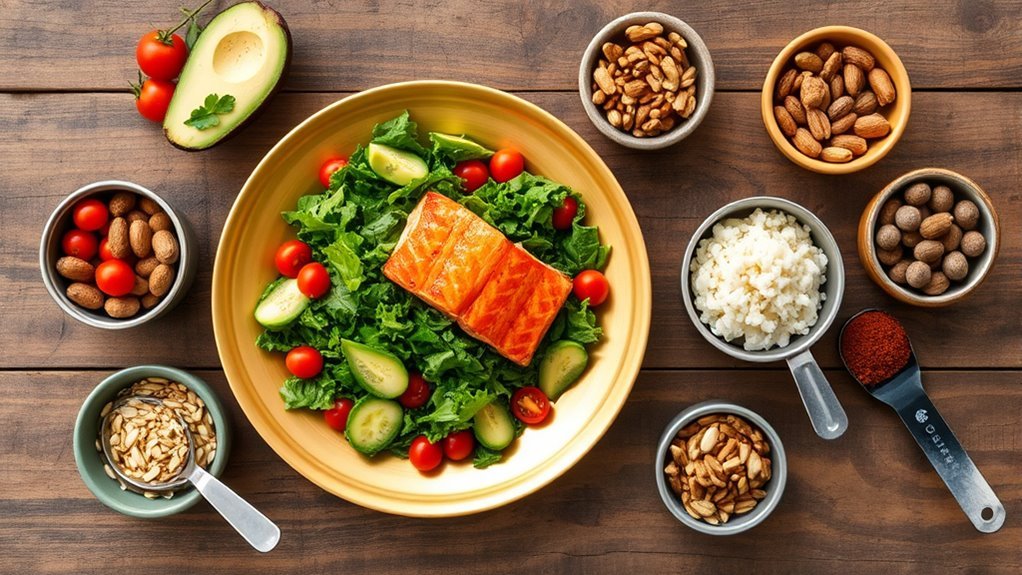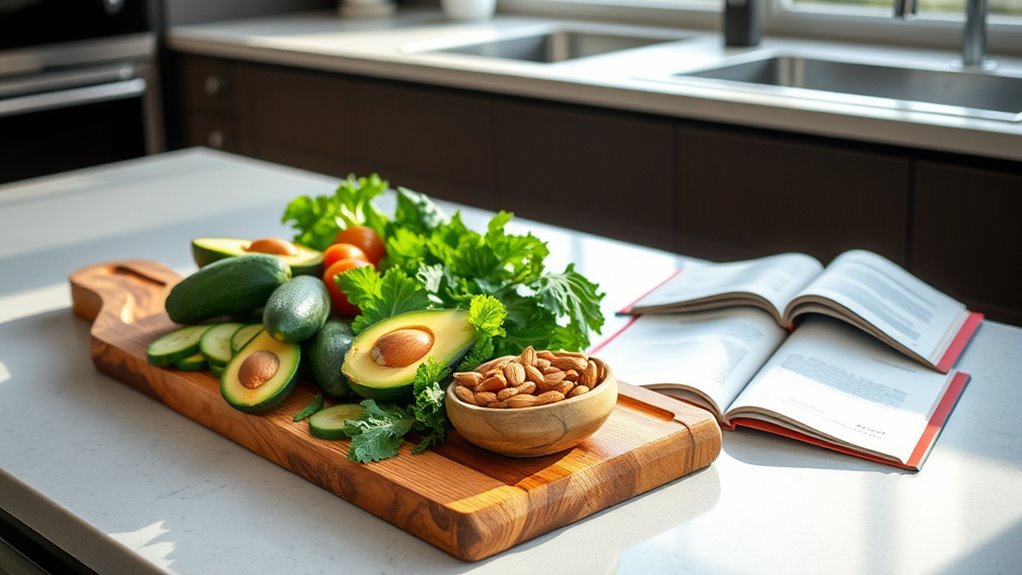In the ketogenic diet, you should limit your daily carbohydrate intake to between 20 and 50 grams. This range helps your body enter ketosis, where it burns fat for energy instead of glucose. Focus on consuming low-carb vegetables and healthy fats while avoiding grains and sugars. Individual factors, like your activity level and metabolic health, may influence the ideal carb amount for you. There’s much more to explore about carb types and meal planning for keto success.
Understanding the Ketogenic Diet

While many people are drawn to the ketogenic diet for its potential weight loss benefits, understanding its core principles is vital for success. One common keto misconception is that all carbohydrates are bad. In reality, the focus should be on limiting high-glycemic carbohydrate sources, such as sugars and refined grains, while incorporating low-carb vegetables and healthy fats. This approach helps your body enter a state of ketosis, where it burns fat for fuel instead of glucose. Furthermore, it’s important to know that not all carbs are created equal; some can provide essential nutrients. By distinguishing between good and bad carbohydrate sources, you can navigate the diet more effectively and maintain the freedom to choose foods that align with your health goals.
What Is Ketosis?

Ketosis is a metabolic state your body enters when it has limited access to carbohydrates for energy, prompting it to burn fat instead. This process results in the production of ketones, which serve as an alternative fuel source. Understanding ketosis can help you recognize its benefits, such as increased fat burning and improved mental clarity.
Ketosis Explained Simply
At its core, ketosis is a metabolic state where your body shifts from using glucose as its primary energy source to burning fat for fuel. When you reduce your carbohydrate intake, especially with low carb snacks, your liver converts fatty acids into ketones, which become your new energy source. This process helps your body utilize stored fat, promoting weight loss. Many people find that entering ketosis can sharpen mental clarity and enhance energy levels, contributing to various keto benefits. To maintain ketosis, it’s essential to manage carbohydrate consumption carefully, typically limiting it to around 20-50 grams per day. This shift not only supports weight management but also encourages metabolic flexibility, giving you more freedom in how your body uses energy.
Benefits of Ketosis
As you enter ketosis, you’ll likely experience a range of benefits that extend beyond weight loss. These ketosis benefits can greatly enhance your overall well-being. Here are a few key health advantages you might notice:
- Increased energy levels: Once your body adapts to burning fat for fuel, many find they have more sustained energy throughout the day.
- Improved mental clarity: Ketones provide a more stable energy source for your brain, often resulting in better focus and cognitive function.
- Reduced hunger: The ketogenic diet can help regulate appetite hormones, leading to fewer cravings and easier adherence to your eating plan.
Embracing ketosis not only aids in weight management but also supports a healthier lifestyle, granting you the freedom to thrive.
Recommended Daily Carb Intake for Keto

When following a keto diet, the standard daily carbohydrate limit is typically set between 20 to 50 grams. However, it’s important to recognize that individual variations, such as activity level and metabolic health, can influence your specific needs. Finding the right carb intake for you may require some experimentation to achieve ideal results.
Standard Carb Limit
The standard carb limit for a ketogenic diet typically falls between 20 to 50 grams of net carbohydrates per day. This range helps your body enter and maintain ketosis, where it burns fat for fuel instead of carbs. To achieve this, you’ll need to be mindful of common standard carb sources and adhere to typical carb restrictions.
- Focus on low-carb vegetables like leafy greens.
- Opt for high-fat proteins such as fatty fish or chicken skin.
- Limit or avoid grains, sugars, and starchy foods.
Sticking to this carb limit can empower you to enjoy the benefits of a keto lifestyle while still allowing for some flexibility in your food choices.
Individual Variations Considered
While the standard carb limit provides a general guideline for those on a ketogenic diet, individual variations can greatly influence the recommended daily carb intake. Your unique body chemistry, activity level, and metabolic rate all play critical roles in determining how many carbs you can consume while maintaining ketosis. For instance, individual metabolic differences can lead to varying responses to carbohydrate intake, meaning some might thrive on fewer carbs, while others may require slightly more to feel their best. Consequently, establishing personalized carb limits is essential. Monitoring your body’s reactions and adjusting as needed can empower you to find the right balance, enabling you to enjoy the benefits of a keto lifestyle while also honoring your own nutritional needs.
Factors Influencing Carb Intake
Understanding the factors that influence carb intake on a keto diet is crucial for achieving and maintaining ketosis. Several elements can dictate how many carbs you should consume:
- Genetic factors: Your individual genetic makeup can affect how your body processes carbohydrates and fats.
- Lifestyle habits: Factors such as physical activity levels, stress management, and sleep quality play a role in how your body utilizes carbs.
- Health goals: Your specific goals, whether weight loss or muscle gain, can impact the amount of carbs you need.
Being aware of these influences allows you to tailor your carb intake more effectively, ensuring you stay within your desired range while enjoying the freedom that a keto diet can offer.
Types of Carbohydrates to Consider
When following a keto diet, it’s essential to reflect on the types of carbohydrates you include in your meals. Opting for fiber-rich foods and low-carb vegetables helps you maintain nutritional balance while staying within your carb limits. Additionally, take into account using sugar substitutes to satisfy your sweet tooth without raising your net carbs.
Here’s a simple overview of carbohydrate types to take into account:
| Carbohydrate Type | Examples | Net Carbs (Approx.) |
|---|---|---|
| Fiber-Rich Foods | Chia seeds, avocados | 1-3 g |
| Low Carb Vegetables | Spinach, zucchini | 2-4 g |
| Sugar Substitutes | Stevia, erythritol | 0-1 g |
| Nuts and Seeds | Almonds, flaxseeds | 2-5 g |
| Berries | Raspberries, strawberries | 5-7 g |
Meal Planning for Keto
Meal planning for a keto diet is essential to guarantee you stay within your carbohydrate limits while still enjoying a variety of tasty foods. Effective keto meal prep can simplify your week and keep you on track. Here are some ideas to reflect on:
- Focus on low carb recipes featuring meats, healthy fats, and non-starchy vegetables.
- Plan your meals around a protein source, like chicken or fish, paired with a variety of leafy greens.
- Batch-cook snacks, such as cheese crisps or nut mixes, to satisfy cravings without breaking your carb count.
Common Mistakes to Avoid
Even with careful meal planning, many people still fall into common pitfalls while on a keto diet. One major issue is carb confusion; not all carbs are created equal. You might underestimate hidden sugars in sauces, dressings, or processed foods, which can sabotage your carb limit. Additionally, relying too heavily on keto snacks can lead to overconsumption of carbs without realizing it. It’s also essential to guarantee you’re getting enough nutrients from non-starchy vegetables rather than focusing solely on fats and proteins. Finally, some individuals may not track their macros diligently, leading to unintended carb intake. By being aware of these common mistakes, you can navigate your keto journey with greater freedom and effectiveness.
Tips for Sticking to Your Carb Limit
To successfully stick to your carb limit on a keto diet, it’s important to establish a clear plan tailored to your dietary needs. Here are some effective tips to help you maintain your goals:
- Use carb tracking apps: These tools simplify monitoring your daily intake, making it easier to stay within limits.
- Practice mindful eating: Focus on your meals without distractions, allowing you to savor flavors and recognize fullness cues.
- Plan meals ahead: Preparing low-carb meals in advance prevents impulsive eating and helps you make informed choices.


